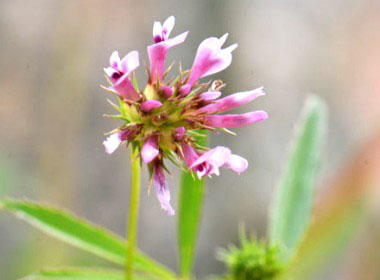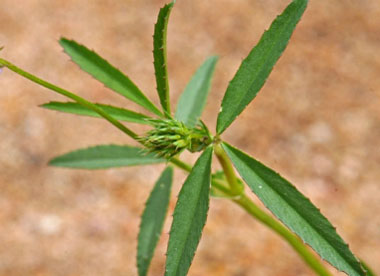




To support our efforts please browse our store (books with health benefits, etc.).
Tomcat clover is an annual wildflower that is native to most areas in the western areas of North America. It is in the Fabaceae family (pea family). This plant germinates in wet winter or spring soils. The scientific name willdenovii refers to the German botanist Carl Ludwig Willdenow (1765-1812). This is a plant many like to grow in their gardens as it attracts pollinators.
Distinguishing Features
This annual plant looks like a typical clover, but with extra long leaves. It is categorized as a wildflower, and it is delicate in appearance. It is somewhat gangly in appearance.
Flowers
Inflorescence about 1 to 3cm wide, stalked, axillary cluster of 6 to 60 pea-like flowers, arranged in a wheel-like shape. Lavender to purple (sometimes purple-pink), 10 to 13 mm long. There are nine united stamens and one free, and the fruit is a mostly 2-seeded pod. Depending on geographic location, the flowers bloom between March and June.
 Fields
of Nutrition has medicinal benefits and vitamin/mineral content of Tomcat Clover.
Fields
of Nutrition has medicinal benefits and vitamin/mineral content of Tomcat Clover.
Leaves
The linear-to-lance oblong or elliptic, green, leaves are alternate, and palmately compound. They grow in leaflets of 3, anywhere from 1 to 4 cm long. The margins are usually finely bristle-toothed.
Height
Although soil and climatic conditions can alter the growth of this plant, typically tomcat clover grows to about 20cm (8”) tall.
Habitat
This clover is primarily found in the western areas of Canada and the U.S. It also occurs in Idaho and Texas. Tomcat clover is also found in Mexico and South America. It is fairly common in grasslands below 5000' and it may be found near the edges of a desert. Tomcat clover also grows in disturbed areas and it can occur in wetlands.
Edible Parts
Leaves are edible raw or cooked. Typically they are better to use before the flower appears. Leaves can be dried to be used in soups, stews or teas. Seeds can also be used raw or cooked. If desired, saved seeds can be sprouted and used in salads. If dried and crushed these seeds can be used as a thickener. According to author Paul Douglas Campbell, in his book Survival Skills of Native California, the Miwok ate tomcat clover. They would eat the leaves, stems and flower buds raw or steamed in an earth oven.
Other Name
Trifolium tridentatum.
Similar Plants
Heartfelt thanks go out to Eugene Sturla of Southwest Desert Flora. His generosity of providing all images of this plant made this page possible.
Winter Survival Food Handbook

PDF Plant Magazines
Types of Wild Food
Geographic Zones Seasons
Disclaimer
EdibleWildFood.com is informational in nature. While we strive to be 100% accurate, it is solely up to the reader to ensure proper plant identification. Some wild plants are poisonous or can have serious adverse health effects.
We are not health professionals, medical doctors, nor are we nutritionists. It is up to the reader to verify nutritional information and health benefits with qualified professionals for all edible plants listed in this web site. Please click here for more information.
Why Edible Wild Food?
- Food costs are rising
- Free, wild food is readily abundant
- Wild food adds nutrition to your diet
- Wild food can help treat various medical conditions





